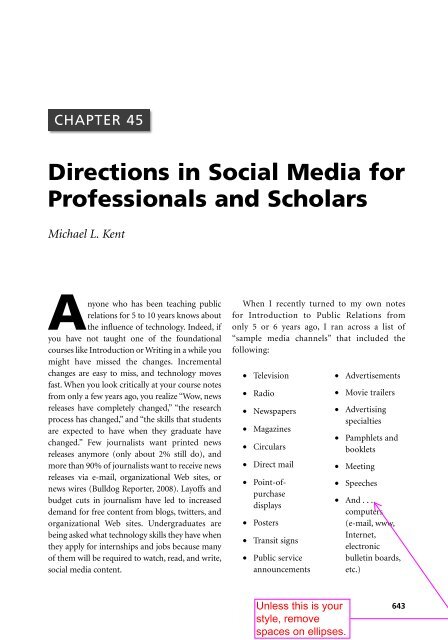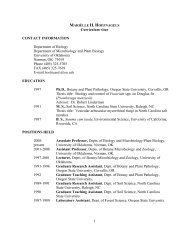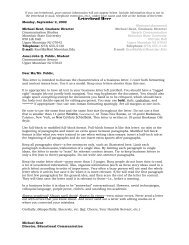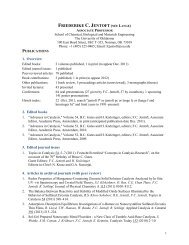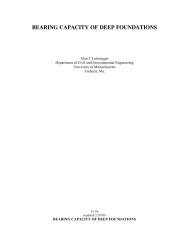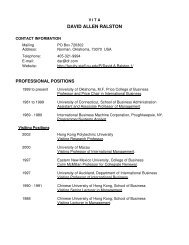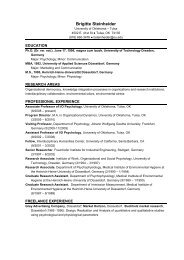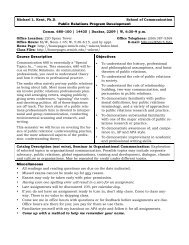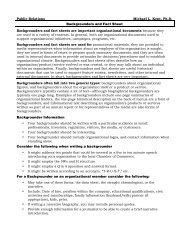Directions in Social Media for Professionals and Scholars
Directions in Social Media for Professionals and Scholars
Directions in Social Media for Professionals and Scholars
Create successful ePaper yourself
Turn your PDF publications into a flip-book with our unique Google optimized e-Paper software.
CHAPTER 45<br />
<strong>Directions</strong> <strong>in</strong> <strong>Social</strong> <strong>Media</strong> <strong>for</strong><br />
<strong>Professionals</strong> <strong>and</strong> <strong>Scholars</strong><br />
Michael L. Kent<br />
Anyone who has been teach<strong>in</strong>g public<br />
relations <strong>for</strong> 5 to 10 years knows about<br />
the <strong>in</strong>fluence of technology. Indeed, if<br />
you have not taught one of the foundational<br />
courses like Introduction or Writ<strong>in</strong>g <strong>in</strong> a while you<br />
might have missed the changes. Incremental<br />
changes are easy to miss, <strong>and</strong> technology moves<br />
fast. When you look critically at your course notes<br />
from only a few years ago, you realize “Wow, news<br />
releases have completely changed,” “the research<br />
process has changed,” <strong>and</strong> “the skills that students<br />
are expected to have when they graduate have<br />
changed.” Few journalists want pr<strong>in</strong>ted news<br />
releases anymore (only about 2% still do), <strong>and</strong><br />
more than 90% of journalists want to receive news<br />
releases via e-mail, organizational Web sites, or<br />
news wires (Bulldog Reporter, 2008). Layoffs <strong>and</strong><br />
budget cuts <strong>in</strong> journalism have led to <strong>in</strong>creased<br />
dem<strong>and</strong> <strong>for</strong> free content from blogs, twitters, <strong>and</strong><br />
organizational Web sites. Undergraduates are<br />
be<strong>in</strong>g asked what technology skills they have when<br />
they apply <strong>for</strong> <strong>in</strong>ternships <strong>and</strong> jobs because many<br />
of them will be required to watch, read, <strong>and</strong> write,<br />
social media content.<br />
When I recently turned to my own notes<br />
<strong>for</strong> Introduction to Public Relations from<br />
only 5 or 6 years ago, I ran across a list of<br />
“sample media channels” that <strong>in</strong>cluded the<br />
follow<strong>in</strong>g:<br />
• Television<br />
• Radio<br />
• Newspapers<br />
• Magaz<strong>in</strong>es<br />
• Circulars<br />
• Direct mail<br />
• Po<strong>in</strong>t-ofpurchase<br />
displays<br />
• Posters<br />
• Transit signs<br />
• Public service<br />
announcements<br />
• Advertisements<br />
• Movie trailers<br />
• Advertis<strong>in</strong>g<br />
specialties<br />
• Pamphlets <strong>and</strong><br />
booklets<br />
• Meet<strong>in</strong>g<br />
• Speeches<br />
• And ...<br />
computers<br />
(e-mail, www,<br />
Internet,<br />
electronic<br />
bullet<strong>in</strong> boards,<br />
etc.)<br />
643
644——PART II: The Practice of Public Relations as Change Management<br />
Ironically, computers were at the bottom of<br />
the list, “h<strong>and</strong>held devices” <strong>and</strong> blogs did not<br />
make the list, <strong>and</strong> Twitter had not been <strong>in</strong>vented.<br />
Over the past 20 years, technology has steadily<br />
advanced from Listservs <strong>in</strong> the late 1980s <strong>and</strong><br />
early 1990s to modern technologies such as the<br />
World Wide Web, social media, <strong>and</strong> social network<strong>in</strong>g<br />
<strong>in</strong> the past 15 years. But as McLuhan<br />
(1999) po<strong>in</strong>ted out <strong>in</strong> 1964, <strong>and</strong> Lev<strong>in</strong>son <strong>in</strong><br />
1997, new technologies do not simply replace old<br />
ones. Old technologies persist, <strong>and</strong> new technologies<br />
fundamentally alter our relationship to<br />
the old ones. This chapter tries to avoid the mistake<br />
many researchers make when exam<strong>in</strong><strong>in</strong>g<br />
“new technologies” of assum<strong>in</strong>g they are new.<br />
Speak<strong>in</strong>g of the Internet, which is more than<br />
40 years old, or “social network<strong>in</strong>g,” which has<br />
been around <strong>for</strong> decades, as “new” is a mistake.<br />
<strong>Social</strong> media, <strong>for</strong> example, are often held up as a<br />
tool <strong>for</strong> social connectivity. However, Granovetter<br />
(1973), writ<strong>in</strong>g decades ago about the value of<br />
hav<strong>in</strong>g large social networks among bus<strong>in</strong>ess professionals,<br />
argued that the success of <strong>in</strong>dividual<br />
messages <strong>and</strong> campaigns often depends on the<br />
experience <strong>and</strong> connections of the communicator<br />
construct<strong>in</strong>g the messages. Once aga<strong>in</strong>, the current<br />
technology offers noth<strong>in</strong>g genu<strong>in</strong>ely new,<br />
only a new way to accomplish an old task.<br />
To expla<strong>in</strong> the complexities of social media,<br />
this chapter will be divided <strong>in</strong>to five sections: The<br />
first section of the chapter will provide some def<strong>in</strong>itions<br />
of key social media concepts as well as<br />
clarify<strong>in</strong>g what is meant by social media from a<br />
public relations st<strong>and</strong>po<strong>in</strong>t. The second section of<br />
the chapter will highlight important social media<br />
literature <strong>and</strong> issues. The third section of the<br />
chapter will discuss the direction of social media<br />
<strong>for</strong> public relations scholars. The fourth section of<br />
the chapter will describe the possible future of<br />
social media <strong>for</strong> communication professionals.<br />
And the fifth section of the chapter will conclude<br />
with some observations about new technology.<br />
The chapter will def<strong>in</strong>e <strong>and</strong> analyze social<br />
media <strong>and</strong> highlight important issues <strong>for</strong> scholars<br />
<strong>and</strong> communication professionals. Topic such<br />
as moderation, <strong>in</strong>teractivity, <strong>in</strong>terchangeability,<br />
prop<strong>in</strong>quity, responsiveness, spontaneity, <strong>and</strong><br />
dialogue are exam<strong>in</strong>ed, <strong>and</strong> theoretical <strong>and</strong> practical<br />
suggestions are made <strong>for</strong> improv<strong>in</strong>g our<br />
underst<strong>and</strong><strong>in</strong>g of social media, how professionals<br />
use it, <strong>and</strong> how academics might study it.<br />
Def<strong>in</strong>itions<br />
As suggested earlier, speak<strong>in</strong>g about technology <strong>in</strong><br />
public relations as “new technology” is a misnomer.<br />
Most of the “new” technologies that we<br />
now regularly use <strong>in</strong> public relations are well<br />
established as communication technologies, with<br />
the Internet <strong>in</strong>troduced <strong>in</strong> the 1960s, e-mail <strong>in</strong> the<br />
1970s, hypertext <strong>in</strong> the 1980s, the World Wide<br />
Web <strong>in</strong> 1993, <strong>and</strong> blogs <strong>in</strong> 1999. Even concepts<br />
such as “social media” are not new. Google now<br />
owns the Usenet archive (<strong>and</strong> still hosts thous<strong>and</strong>s<br />
of groups), one of the first “social media.” Usenet<br />
was started <strong>in</strong> 1981 <strong>and</strong> conta<strong>in</strong>s 500 million<br />
back-<strong>and</strong>-<strong>for</strong>th posts by tens of millions of<br />
people from more than 3.5 million groups.<br />
Electronic mail<strong>in</strong>g lists like the National<br />
Communication Association’s (NCA) list CRT-<br />
NET (Communication, Research, <strong>and</strong> Theory<br />
Network), started <strong>in</strong> 1989 by Tom Benson at the<br />
Pennsylvania State University, have been host<strong>in</strong>g<br />
member dialogue <strong>for</strong> more than two decades.<br />
Internet Relay Chat (IRC), started <strong>in</strong> the early<br />
1990s, is also still go<strong>in</strong>g strong, as are the <strong>in</strong>famous<br />
“chat rooms” where we occasionally hear<br />
about adolescents gett<strong>in</strong>g <strong>in</strong>to trouble. Thus,<br />
call<strong>in</strong>g our Internet communication technologies<br />
“new” makes people th<strong>in</strong>k that we do not already<br />
know a lot about them, which we do. Indeed,<br />
many of the early critiques of the Internet, of<br />
which we see very little of <strong>in</strong> most literature<br />
reviews, were critical (cf. Elmer, 1997; Kent, 2001;<br />
Mitra, 1997; Warnick, 1998) <strong>and</strong> focused on<br />
underst<strong>and</strong><strong>in</strong>g the medium rather than work<strong>in</strong>g<br />
out technical details.<br />
In spite of the fact that there are decades of<br />
research, thous<strong>and</strong>s of scholarly articles about<br />
“new communication technologies,” <strong>and</strong> hundreds<br />
of articles just from communication <strong>and</strong> public<br />
relations sources, some scholars of new technology<br />
are actually turn<strong>in</strong>g to onl<strong>in</strong>e (nonrefereed)
sources like Wikipedia <strong>for</strong> def<strong>in</strong>itions <strong>and</strong> proof <strong>for</strong><br />
claims (cf. Terilli, Driscoll, & Stacks, 2008; Wright<br />
& H<strong>in</strong>son, 2009a, 2009b). More important, when<br />
many scholars talk about new communication<br />
technologies, they take an implicit ontological<br />
stance about technology that assumes that dialogue,<br />
rhetoric, <strong>and</strong> persuasion are present, but<br />
completely ignore the actual use of the technology<br />
by public relations professionals, focus<strong>in</strong>g on selfreport<br />
data <strong>and</strong> content analyses.<br />
What Are <strong>Social</strong> <strong>Media</strong><br />
<strong>and</strong> <strong>Social</strong> Network<strong>in</strong>g?<br />
Chapter 45 <strong>Directions</strong> <strong>in</strong> <strong>Social</strong> <strong>Media</strong> <strong>for</strong> <strong>Professionals</strong> <strong>and</strong> <strong>Scholars</strong>——645<br />
On the most basic level, any <strong>in</strong>teractive communication<br />
channel that allows <strong>for</strong> two-way <strong>in</strong>teraction<br />
<strong>and</strong> feedback could be called a social<br />
media (Listservs, e-mail, radio call-<strong>in</strong> programs,<br />
etc.). Shortwave radio, Citizen’s B<strong>and</strong> (CB)<br />
radio, <strong>and</strong> the telephone are probably the oldest<br />
broadcast media that allow <strong>for</strong> social <strong>in</strong>teraction<br />
<strong>and</strong> network<strong>in</strong>g.<br />
Modern social networks are characterized by<br />
the potential <strong>for</strong> real-time <strong>in</strong>teraction, reduced<br />
anonymity (with Facebook, MySpace, L<strong>in</strong>kedIn,<br />
etc., but not with blogs <strong>and</strong> lists), a sense of<br />
prop<strong>in</strong>quity (brought on by the use of avatars,<br />
graphical <strong>in</strong>terfaces, automated messages, etc.),<br />
short response times (often because of the number<br />
of users/members participat<strong>in</strong>g), <strong>and</strong> the ability<br />
to “time shift,” or engage the social network<br />
whenever suits each particular member. Thus,<br />
blogs, Twitter, Facebook, <strong>and</strong> MySpace are considered<br />
social media because of the responsiveness<br />
of participants <strong>and</strong> the vastness of networks,<br />
as are <strong>in</strong>teractive Listservs, newsgroups, Usenet,<br />
<strong>and</strong> real-time chats like IRC.<br />
More traditional <strong>for</strong>ms of social media<br />
(personal letters, letters to the editor, videoconferenc<strong>in</strong>g,<br />
etc.) are not thought of the same way<br />
because they are often not capable of support<strong>in</strong>g<br />
<strong>in</strong>teractions by people <strong>in</strong> vast social networks,<br />
because they do not take place <strong>in</strong> “real time,” <strong>and</strong>,<br />
perhaps most important, because they do not allow<br />
time shift<strong>in</strong>g. As few as five people would have<br />
difficulty hold<strong>in</strong>g a coherent, shared conversation<br />
via postal mail, while hundreds, sometimes<br />
thous<strong>and</strong>s, regularly contribute to onl<strong>in</strong>e blog<br />
posts or Facebook messages us<strong>in</strong>g “threaded dialogue.”<br />
<strong>Social</strong> media have several other def<strong>in</strong><strong>in</strong>g<br />
features: moderation, <strong>in</strong>teractivity, <strong>in</strong>terchangeability,<br />
prop<strong>in</strong>quity, responsiveness, spontaneity,<br />
<strong>and</strong> dialogue.<br />
Moderation. Moderation refers to editorial oversight<br />
rather than conservativeness. For example,<br />
successfully post<strong>in</strong>g a message to the NCA’s CRT-<br />
NET Listserv requires that your message be read<br />
by the list moderator, who decides if the post is<br />
appropriate <strong>for</strong> distribution to the list. The same<br />
is true of many blogs. Other Listservs <strong>and</strong> blogs<br />
are completely open, allow<strong>in</strong>g anyone (or anyone<br />
with an account) to upload posts respond<strong>in</strong>g to<br />
specific blog content or messages from fellow<br />
readers. Unmoderated blogs are uncommon<br />
because they are often flooded with advertisements<br />
<strong>for</strong> drugs, porn, <strong>and</strong> other <strong>in</strong>appropriate<br />
messages from bots <strong>and</strong> spammers.<br />
However, not all social media sites are moderated<br />
<strong>in</strong> the same way. The blog SlashDot<br />
(SlashDot.org) enlists the help of its members to<br />
moderate the site, select<strong>in</strong>g hundreds of members<br />
each week <strong>and</strong> assign<strong>in</strong>g them “moderator<br />
po<strong>in</strong>ts” enabl<strong>in</strong>g them to raise or lower the score<br />
<strong>for</strong> particular posts. Because moderators have<br />
limited po<strong>in</strong>ts, only <strong>in</strong>appropriate posts are<br />
scored down, <strong>and</strong> exceptional posts scored up.<br />
Subscribers to the blog are also allowed to select<br />
their threshold of content quality, read<strong>in</strong>g only<br />
four <strong>and</strong> five star posts <strong>and</strong> ignor<strong>in</strong>g the rest,<br />
read<strong>in</strong>g everyth<strong>in</strong>g, <strong>and</strong> so on. Many blog moderators<br />
filter only <strong>in</strong>appropriate content but<br />
allow all other posts through.<br />
Moderation is a part of all social media,<br />
whether it is employed or not. Facebook,<br />
L<strong>in</strong>kedIn, <strong>and</strong> other social network<strong>in</strong>g sites, <strong>for</strong><br />
example, allow the site owner (moderator) to<br />
decide who will be granted access. Facebook <strong>and</strong><br />
L<strong>in</strong>kedIn require the “moderator” to grant permission<br />
to others to jo<strong>in</strong> (when they receive a<br />
“friend request,” etc.).<br />
Ironically, moderat<strong>in</strong>g social media is antisocial.<br />
<strong>Social</strong> media create the illusion of know<strong>in</strong>g
646——PART II: The Practice of Public Relations as Change Management<br />
what someone is do<strong>in</strong>g by see<strong>in</strong>g the posts by<br />
others on their social network<strong>in</strong>g pages <strong>and</strong> read<strong>in</strong>g<br />
the comments to their own posts. However,<br />
social media are not “social” <strong>in</strong> the sense of hav<strong>in</strong>g<br />
your close friends over <strong>for</strong> dr<strong>in</strong>ks or tea.<br />
Rather, social media are like a party. Because<br />
“everyone” is there, few people pay much attention<br />
to anyone, even close friends. Everyone<br />
knows that their conversations might be overheard,<br />
so they do not really disclose too much,<br />
except if they are st<strong>and</strong><strong>in</strong>g off <strong>in</strong> a corner (or<br />
send<strong>in</strong>g a private message on a social network<strong>in</strong>g<br />
site). As a result, be<strong>in</strong>g truly social cannot be<br />
done on a social network<strong>in</strong>g site. Their public<br />
nature precludes <strong>in</strong>timateness, self-disclosure,<br />
<strong>and</strong> genu<strong>in</strong>e sociality. Intimacy requires privacy.<br />
Stories abound <strong>in</strong> the media of young people<br />
post<strong>in</strong>g <strong>in</strong>appropriate content on their Facebook<br />
pages or not underst<strong>and</strong><strong>in</strong>g the difference between<br />
public <strong>and</strong> private <strong>in</strong><strong>for</strong>mation <strong>and</strong> conversations<br />
(Bahney, 2006). Government employees, graduate<br />
students, bus<strong>in</strong>ess professionals, job applicants,<br />
<strong>in</strong>terns, <strong>and</strong> high school <strong>and</strong> college students have<br />
gotten <strong>in</strong>to trouble with social media.<br />
<strong>Social</strong> media give the illusion of allow<strong>in</strong>g<br />
people to pick their friends <strong>and</strong> colleagues <strong>and</strong><br />
create an environment of freedom <strong>and</strong> democracy.<br />
In practice, however, professionals often feel<br />
pressured to grant entry to supervisors <strong>and</strong> colleagues<br />
<strong>for</strong> fear of suffer<strong>in</strong>g sometimes serious<br />
consequences. Thous<strong>and</strong>s of people have been<br />
fired <strong>for</strong> blogg<strong>in</strong>g <strong>and</strong> post<strong>in</strong>g comments about<br />
their employers, <strong>and</strong> people with active social<br />
network<strong>in</strong>g sites need to spend a great deal of<br />
time post<strong>in</strong>g <strong>and</strong> read<strong>in</strong>g comments. As a result,<br />
many active social networkers ma<strong>in</strong>ta<strong>in</strong> alternative<br />
social media sites <strong>for</strong> their “real friends.”<br />
Thus, all social media require some level of<br />
ma<strong>in</strong>tenance <strong>and</strong> moderation.<br />
Interactivity. Interactivity has long been a feature<br />
of social media go<strong>in</strong>g back to the early Listservs <strong>and</strong><br />
professional “hotl<strong>in</strong>es” (cf. CIOS: Communication<br />
Institute <strong>for</strong> Onl<strong>in</strong>e <strong>Scholars</strong>hip). However, the<br />
vast majority of people read blogs or monitor<br />
twitters, rather than post to them. In the early days<br />
of the Internet, these people were called “lurkers.”<br />
Twenty years ago, active participants to lists would<br />
compla<strong>in</strong> about people who just read the posts by<br />
others <strong>and</strong> never participated <strong>in</strong> the dialogue.<br />
Modern social media such as Facebook,<br />
YouTube, <strong>and</strong> L<strong>in</strong>kedIn have actually <strong>in</strong>stitutionalized<br />
participation. For example, on Facebook,<br />
“friends” can give a “thumbs up” or “thumbs<br />
down” rat<strong>in</strong>g to the posts of others with very little<br />
ef<strong>for</strong>t. Little substantive discussion actually<br />
takes place publicly. Most people just post pictures<br />
of their out<strong>in</strong>g with their kids at the lake or<br />
the results of their latest onl<strong>in</strong>e IQ test or<br />
achievement <strong>in</strong> FarmVille. On most social network<strong>in</strong>g<br />
sites, symbolic participation, or faux<br />
<strong>in</strong>teraction, takes the place of genu<strong>in</strong>e <strong>in</strong>teraction<br />
(Kent, Harrison, & Taylor, 2006).<br />
More conversational <strong>and</strong> back-<strong>and</strong>-<strong>for</strong>th discussion<br />
takes place on blogs than on personal<br />
<strong>and</strong> professional social network<strong>in</strong>g sites. On the<br />
one h<strong>and</strong>, substantive blog conversations make<br />
sense; blogs br<strong>in</strong>g to readers <strong>and</strong> subscribers new<br />
<strong>in</strong><strong>for</strong>mation <strong>and</strong> topics of discussion. After all,<br />
how much can someone say about pictures of<br />
your nephew’s picnic at the Jersey shore?—<br />
“Dude, that looked like it rocked!” However, a<br />
blog post<strong>in</strong>g about a new health or technological<br />
<strong>in</strong>novation, or a political decision by the president,<br />
can spur heated commentary. Still, anyone<br />
who belongs to several social network<strong>in</strong>g sites<br />
knows that most members are lurkers, <strong>and</strong> most<br />
sites receive the majority of their post<strong>in</strong>gs from a<br />
h<strong>and</strong>ful of participants.<br />
That most people are lurkers rather than discussants<br />
has a lot of implications. Aga<strong>in</strong>, as suggested<br />
above, social media turn out to be not all<br />
that social. Many, perhaps most, people use social<br />
network<strong>in</strong>g sites to satisfy their socio-emotional<br />
needs of <strong>in</strong>clusion <strong>and</strong> acknowledgement. As<br />
Rogers (1957) suggested, humans have an <strong>in</strong>nate<br />
need to be acknowledged <strong>and</strong> <strong>in</strong>cluded. We are<br />
social be<strong>in</strong>gs. Although not everyone needs to be<br />
the center of attention as some bloggers do,<br />
everyone wants to feel a part of a social network.<br />
Interactivity both af<strong>for</strong>ds an opportunity to<br />
respond to others (sometimes anonymously, as a<br />
r<strong>and</strong>om blog poster, etc.) <strong>and</strong> <strong>in</strong>itiates contact,<br />
giv<strong>in</strong>g a “shout out” to your “peeps” or upload<strong>in</strong>g
Chapter 45 <strong>Directions</strong> <strong>in</strong> <strong>Social</strong> <strong>Media</strong> <strong>for</strong> <strong>Professionals</strong> <strong>and</strong> <strong>Scholars</strong>——647<br />
your own content or messages on Facebook,<br />
YouTube, or another social media site.<br />
Interchangeability. <strong>Social</strong> network<strong>in</strong>g participants<br />
are more or less <strong>in</strong>terchangeable. Go<strong>in</strong>g<br />
back to the early days of social media, the IRCs<br />
<strong>and</strong> AOL chat rooms, we know that many people<br />
disguise their identities. Gender experimentation,<br />
where men pretend to be women <strong>and</strong> women pretend<br />
to be men, was (<strong>and</strong> still is) common on<br />
these lean, text-based, networks. Additionally,<br />
early social media were characterized by <strong>in</strong>teraction<br />
among total strangers.<br />
Many of the modern social media networks<br />
share this feature of l<strong>in</strong>k<strong>in</strong>g anonymous strangers<br />
together. If I accept a friend’s request on Facebook,<br />
<strong>for</strong> example, I am then offered the opportunity to<br />
select from among his or her friends, shopp<strong>in</strong>g<br />
<strong>for</strong> “friends” that both participants might have <strong>in</strong><br />
common. Similarly, I am often sent requests by<br />
total strangers to jo<strong>in</strong> my own L<strong>in</strong>kedIn network.<br />
When I follow up on the background of the person<br />
send<strong>in</strong>g me the request, I often discover that<br />
the stranger <strong>and</strong> I have absolutely noth<strong>in</strong>g <strong>in</strong><br />
common (bankers, real estate agents, etc.). The<br />
opportunity to create a network of anonymous<br />
friends <strong>and</strong> follow the antics of total strangers<br />
exists to a greater extent with Twitter, where I<br />
have lists of “followers” (people or organizations<br />
who are follow<strong>in</strong>g me), <strong>and</strong> “follow<strong>in</strong>g” (people<br />
<strong>and</strong> organizations who I am follow<strong>in</strong>g). The<br />
opportunity to keep on top of Ashton Kutcher’s<br />
d<strong>in</strong><strong>in</strong>g habits or “L<strong>in</strong>dsay Lohan’s Twitter tra<strong>in</strong>wreck”<br />
is very compell<strong>in</strong>g.<br />
The po<strong>in</strong>t here is people on many social media<br />
sites are <strong>in</strong>terchangeable. Sites are designed to<br />
build wide networks by shar<strong>in</strong>g <strong>in</strong><strong>for</strong>mation<br />
among members. Apart from social network<strong>in</strong>g<br />
with one’s actual family <strong>and</strong> genu<strong>in</strong>e “friends,”<br />
everyone else is <strong>in</strong>terchangeable. If Richard<br />
Edelman stopped blogg<strong>in</strong>g, I could follow some<br />
other blog. If I was <strong>in</strong>terested <strong>in</strong> reach<strong>in</strong>g key<br />
publics through an organizational blog, I could<br />
affiliate with new colleagues <strong>and</strong> professionals<br />
who share similar <strong>in</strong>terests. With the exception of<br />
people whom we actually know <strong>and</strong> see regularly,<br />
everyone else might be computer generated. My<br />
Twitter “followers” are not necessarily who they<br />
say they are, <strong>and</strong> it is not necessary to blog, twitter,<br />
or Facebook to be professionally successful.<br />
Moreover, the time spent “social network<strong>in</strong>g”<br />
(social media qua enterta<strong>in</strong>ment), rather than<br />
simply us<strong>in</strong>g social media like blogs <strong>for</strong> professional<br />
purposes (social media qua research)<br />
(cf. Kent, 2008a), is unlikely to result <strong>in</strong> any big<br />
professional dividends (Regan, 2007).<br />
F<strong>in</strong>ally, go<strong>in</strong>g back to an earlier po<strong>in</strong>t mentioned<br />
<strong>in</strong> “moderation,” because people’s “social<br />
networks” <strong>in</strong>clude friends, family, coworkers, colleagues,<br />
supervisors, <strong>and</strong> professionals from<br />
other organizations <strong>and</strong> <strong>in</strong>dustries, no c<strong>and</strong>id or<br />
substantive advice or counsel is possible. An<br />
employee who negatively blogs about his or her<br />
employer is likely to be fired; thus, the blog needs<br />
to be “anonymous,” dim<strong>in</strong>ish<strong>in</strong>g its credibility<br />
<strong>and</strong> veracity. The same risk entails from post<strong>in</strong>g<br />
to <strong>in</strong>dustry blogs, as well as post<strong>in</strong>g c<strong>and</strong>id comments<br />
on one’s own social media sites. Thus, any<br />
“dialogue” that ensues—on order with pabulum<br />
<strong>and</strong> frequently just self-serv<strong>in</strong>g rants—<strong>in</strong> no way<br />
resembles what Granovetter (1973) described <strong>in</strong><br />
“The Strength of Weak Ties”:<br />
The overall social structural picture suggested<br />
by this argument can be seen by consider<strong>in</strong>g<br />
the situation of some arbitrarily<br />
selected <strong>in</strong>dividual—call him Ego. Ego will<br />
have a collection of close friends, most of<br />
whom are <strong>in</strong> touch with one another—a<br />
densely knit clump of social structure.<br />
Moreover, Ego will have a collection of<br />
acqua<strong>in</strong>tances, few of whom know one<br />
another. Each of these acqua<strong>in</strong>tances, however,<br />
is likely to have close friends <strong>in</strong> his own<br />
right <strong>and</strong> there<strong>for</strong>e to be enmeshed <strong>in</strong> a<br />
closely knit clump of social structure, but one<br />
different from Ego’s. The weak tie between<br />
Ego <strong>and</strong> his acqua<strong>in</strong>tance, there<strong>for</strong>e, becomes<br />
not merely a trivial acqua<strong>in</strong>tance tie but<br />
rather a crucial bridge between the two<br />
densely knit clumps of close friends. To the<br />
extent that the assertion of the previous paragraph<br />
is correct, these clumps would not, <strong>in</strong><br />
fact, be connected to one another at all were<br />
it not <strong>for</strong> the existence of weak ties. (p. 1363)
648——PART II: The Practice of Public Relations as Change Management<br />
<strong>Social</strong> network<strong>in</strong>g sites are not about “professional<br />
network<strong>in</strong>g,” as takes place at a conference,<br />
or with one’s colleagues <strong>in</strong> the hall, but about<br />
“sociability.” The friends, colleagues, blog, <strong>and</strong><br />
Twitter sites followed are largely arbitrary, <strong>and</strong> an<br />
<strong>in</strong>dividual’s participation <strong>in</strong> the network is as<br />
<strong>in</strong>terchangeable as watch<strong>in</strong>g the nightly news on<br />
one channel rather than another.<br />
Prop<strong>in</strong>quity. Prop<strong>in</strong>quity is often talked about as<br />
a feature of dialogue. Prop<strong>in</strong>quity means closeness<br />
or proximity—nearness. We have the<br />
strongest relationships with those we share physical<br />
space with. As we know from the <strong>in</strong>terpersonal<br />
communication literature, relationships<br />
are built over time <strong>and</strong> through shared <strong>in</strong>teractions.<br />
Relationships are also built through selfdisclosure<br />
<strong>and</strong> genu<strong>in</strong>e contact. Be<strong>in</strong>g a member<br />
of the same professional association (blog,<br />
Twitter, or Facebook) does not equate with<br />
friendship. As has been argued by Kent <strong>and</strong><br />
Taylor (1998, 2002), Web sites, <strong>and</strong> by extension,<br />
social media sites, have the potential to function<br />
dialogically, as relationship build<strong>in</strong>g tools; however,<br />
actual <strong>in</strong>tellectual contact is required <strong>for</strong><br />
this to happen. Wikipedia, <strong>for</strong> example, has a lot<br />
of <strong>in</strong><strong>for</strong>mation on it, but it fosters no sense of<br />
closeness, s<strong>in</strong>ce it is little more than a dictionary.<br />
<strong>Social</strong> media, on the other h<strong>and</strong>, have the “potential”<br />
to build relationships because of the shared<br />
sense of connection engendered by the media.<br />
But without devot<strong>in</strong>g time <strong>and</strong> energy to <strong>in</strong>teraction,<br />
social media fail.<br />
Although the sense of prop<strong>in</strong>quity fostered by<br />
social media sites is illusory, they do provide the<br />
ground <strong>for</strong> creat<strong>in</strong>g stronger professional relationships.<br />
Relationships, however, need to be<br />
nurtured. A professional <strong>in</strong>terested <strong>in</strong> build<strong>in</strong>g a<br />
strong relationship with a fellow professional is<br />
likely to have more success <strong>and</strong> develop a<br />
stronger bond by spend<strong>in</strong>g time with the other<br />
person at a local event, a professional conference,<br />
or over lunch than via e-mail or a social network<strong>in</strong>g<br />
site. S<strong>in</strong>ce strong relationships are<br />
premised on shared experience <strong>and</strong> underst<strong>and</strong><strong>in</strong>g,<br />
social media provide an opportunity to<br />
create a sense of identification by unawareness<br />
(Burke, 1973) that is part of all true relationships.<br />
Responsiveness. Responsiveness is a feature of<br />
most social media. As noted above, some social<br />
media sites like blogs do not allow all visitors to<br />
post comments, <strong>and</strong> many sites only allow comments<br />
by members (someth<strong>in</strong>g that has been<br />
true s<strong>in</strong>ce the early days of social media).<br />
Responsiveness gets played out <strong>in</strong> a number of<br />
ways. Probably, the most common way is through<br />
threaded dialogue. Threaded dialogue is conversation<br />
that emerges <strong>in</strong> response to news or conversational<br />
posts (or “threads”). Other <strong>for</strong>ms of<br />
social media allow <strong>for</strong> responses to be posted by<br />
members <strong>and</strong> participants but are not threaded.<br />
For example, recently on CRTNET (NAT-<br />
COM.org), Richard Vatz posted a comment<br />
about whether NCA should be provid<strong>in</strong>g m<strong>in</strong>ority<br />
grants to graduate students. The orig<strong>in</strong>al<br />
comment sparked substantial controversy, with<br />
dozens of members of the list post<strong>in</strong>g lengthy<br />
comments over the course of several weeks.<br />
However, because NCA’s list is moderated <strong>and</strong><br />
has a time delay that varies from hours to a day<br />
or more, depend<strong>in</strong>g on when the list moderator<br />
is able to vet <strong>and</strong> upload member posts, hav<strong>in</strong>g<br />
threaded conversations that refer to other posts<br />
<strong>and</strong> move back <strong>and</strong> <strong>for</strong>th between the comments<br />
of others is more difficult. Some of the content<br />
that someone might reference <strong>in</strong> a threaded context<br />
are be<strong>in</strong>g uploaded at the same time as<br />
yours, with the other five comments that came <strong>in</strong><br />
between 5 p.m. <strong>and</strong> 8 a.m. A genu<strong>in</strong>ely threaded<br />
context such as what is found on many blogs<br />
(e.g., SlashDot.org) has the potential to be more<br />
like genu<strong>in</strong>e dialogue, with comments appear<strong>in</strong>g<br />
<strong>in</strong> reverse chronological order, <strong>in</strong> real time, <strong>and</strong><br />
with the ability to reference, <strong>in</strong>corporate, <strong>and</strong><br />
<strong>in</strong>terrogate the comments <strong>and</strong> <strong>in</strong>sights of others.<br />
Completely open social media often attract “v<strong>and</strong>als”<br />
who use foul language, post <strong>in</strong>appropriate<br />
comments, <strong>in</strong>sult members, <strong>and</strong> occasionally<br />
upload l<strong>in</strong>ks to compet<strong>in</strong>g content. Thus, most<br />
social media sites <strong>for</strong> professionals are moderated.<br />
Responsiveness, then, is a feature of social
Chapter 45 <strong>Directions</strong> <strong>in</strong> <strong>Social</strong> <strong>Media</strong> <strong>for</strong> <strong>Professionals</strong> <strong>and</strong> <strong>Scholars</strong>——649<br />
media, but its implementation <strong>and</strong> value vary<br />
tremendously <strong>and</strong> affect the nature of the social<br />
experience.<br />
Dialogue. Public relations <strong>and</strong> many other communication-oriented<br />
professions have been<br />
mov<strong>in</strong>g back toward rhetorical, relational, <strong>and</strong><br />
dialogic communication models. Marketers are<br />
<strong>in</strong>creas<strong>in</strong>gly <strong>in</strong>terested <strong>in</strong> “relationship build<strong>in</strong>g”<br />
(currently reified as br<strong>and</strong> loyalty, but <strong>in</strong>creas<strong>in</strong>gly<br />
more focused on build<strong>in</strong>g more tangible relationships<br />
of trust <strong>and</strong> commitment). Politicians<br />
have been showcas<strong>in</strong>g their <strong>in</strong>volvement <strong>in</strong> their<br />
communities by host<strong>in</strong>g “town halls” <strong>and</strong> provid<strong>in</strong>g<br />
onl<strong>in</strong>e content. Public relations professionals<br />
have long recognized the power of relationships<br />
to foster trust <strong>and</strong> loyalty.<br />
The pr<strong>in</strong>ciples of dialogue were first outl<strong>in</strong>ed<br />
by a number of <strong>in</strong>terpersonal <strong>and</strong> relational<br />
scholars, professionals, <strong>and</strong> philosophers. Mart<strong>in</strong><br />
Buber (1970) is generally considered the father of<br />
dialogue, but others, <strong>in</strong>clud<strong>in</strong>g Bahkt<strong>in</strong> (1981),<br />
La<strong>in</strong>g (1969), <strong>and</strong> Rogers (1957), have contributed.<br />
In public relations, Ron Pearson (1989)<br />
as well as Kent <strong>and</strong> Taylor (1998, 2002) have also<br />
contributed.<br />
<strong>Social</strong> media revolve around what is essentially<br />
a central tenet of dialogue: the value of the <strong>in</strong>dividual.<br />
One of the problems with the way that<br />
social media <strong>and</strong> dialogue <strong>in</strong>teract, however, is<br />
that social media, as has been expla<strong>in</strong>ed above, are<br />
not very social. When Mart<strong>in</strong> Buber (1970) wrote<br />
about dialogue almost a century ago <strong>in</strong> 1923, he<br />
envisioned face-to-face <strong>in</strong>teractions of genu<strong>in</strong>eness,<br />
empathy, <strong>and</strong> compassion: There were no<br />
superstores, there was no cable television, there<br />
were no cellular telephones, <strong>and</strong> there were no<br />
social networks that did not <strong>in</strong>volve human<br />
be<strong>in</strong>gs <strong>in</strong>teract<strong>in</strong>g with each other face to face.<br />
Some public relations professionals have<br />
argued that sometimes “we do not want a genu<strong>in</strong>e<br />
<strong>in</strong>teraction, we just want to get our groceries<br />
<strong>and</strong> go home.” However, Buber’s (1970) dream<br />
<strong>and</strong> the dream of most dialogic scholars is a<br />
world where people have time <strong>and</strong> a desire to<br />
<strong>in</strong>teract with their fellow human be<strong>in</strong>gs.<br />
Dialogue is an activity of patience <strong>and</strong> underst<strong>and</strong><strong>in</strong>g.<br />
Thus, <strong>for</strong> social media to live up to the<br />
dialogic promise suggested by Buber (1970) <strong>and</strong><br />
Kent <strong>and</strong> Taylor (1998, 2002), they need to actually<br />
be capable of deal<strong>in</strong>g with people, all people,<br />
as valued <strong>and</strong> trusted companions.<br />
Many of the def<strong>in</strong>itions of social media that<br />
are advanced by scholars limit themselves to<br />
description, never exam<strong>in</strong><strong>in</strong>g the assumptions<br />
beh<strong>in</strong>d their research or the appropriateness of<br />
their methodology <strong>for</strong> the phenomenon <strong>in</strong> question.<br />
There exists very little critical analysis of<br />
social media <strong>for</strong> scholars to draw on. For example,<br />
Waters, Burnett, Lamm, <strong>and</strong> Lucas (2009) wrote,<br />
“Relationships are the foundation <strong>for</strong> social network<strong>in</strong>g<br />
sites” (p. 102) <strong>and</strong> “The purpose of this<br />
study is to exam<strong>in</strong>e how nonprofit organizations<br />
use Facebook to engage their stakeholders <strong>and</strong><br />
foster relationship growth” (p. 103). Although the<br />
article provides some useful f<strong>in</strong>d<strong>in</strong>gs, there is a<br />
disconnect between what social network<strong>in</strong>g sites<br />
are <strong>for</strong> “relationships,” <strong>and</strong> what the authors<br />
study. The authors do not actually look at “how<br />
nonprofit organizations use Facebook to engage<br />
their stakeholders.” They sent no messages to the<br />
nonprofits to see if they responded (responsiveness<br />
is someth<strong>in</strong>g that previous researchers have<br />
shown to be very low among all types of organizations),<br />
posted no messages to their walls to see<br />
how the organization engaged them, nor content<br />
analyzed the quality <strong>and</strong> quantity of the comments<br />
that were posted. Yet Waters et al. concluded<br />
that nonprofit organizations “rarely<br />
provide <strong>in</strong><strong>for</strong>mation <strong>in</strong> <strong>for</strong>ms other than external<br />
l<strong>in</strong>ks to news stories, photographs, <strong>and</strong> discussion<br />
board posts” (p. 105).<br />
Because this was a study of “social network<strong>in</strong>g,”<br />
<strong>and</strong> assumed that “relationships are the<br />
foundation,” the authors really discovered that<br />
these types of organizations are not really do<strong>in</strong>g<br />
any social network<strong>in</strong>g. The conclusion seems to<br />
be that the organizations might be us<strong>in</strong>g social<br />
network<strong>in</strong>g sites <strong>for</strong> market<strong>in</strong>g purposes, or to<br />
offer another Web presence, but not to actually<br />
engage people “socially.” The problem with<br />
Waters et al.’s study is not methodological or that
650——PART II: The Practice of Public Relations as Change Management<br />
their f<strong>in</strong>d<strong>in</strong>gs are flawed; the problem is that<br />
there is a contradiction between how we def<strong>in</strong>e<br />
<strong>and</strong> how we study social media.<br />
Even more substantive essays on social network<strong>in</strong>g<br />
such as Wright <strong>and</strong> H<strong>in</strong>son’s (2008),<br />
published <strong>in</strong> the Public Relations Journal, often<br />
proceed from flawed assumptions. Sett<strong>in</strong>g aside<br />
the fact that the article conta<strong>in</strong>s only two references<br />
to public relations books or articles<br />
(Public Relations Tactics <strong>and</strong> PR Week) <strong>and</strong> two<br />
references to conference papers (both by the<br />
authors), the rema<strong>in</strong>der of the citations are to<br />
blogs, Web sites, bus<strong>in</strong>ess <strong>and</strong> market<strong>in</strong>g journals,<br />
<strong>and</strong> so on. No public relations body of literature<br />
is <strong>in</strong>voked <strong>in</strong> the essay to support the<br />
assumptions made by the authors or the conclusions<br />
drawn <strong>in</strong> the essay. Wright <strong>and</strong> H<strong>in</strong>son<br />
(2008) wrote,<br />
David Meerman Scott ..., an onl<strong>in</strong>e thought<br />
leadership <strong>and</strong> viral market<strong>in</strong>g strategist,<br />
says, “one of the coolest th<strong>in</strong>gs about the Web<br />
is that when an idea takes off it can propel a<br />
br<strong>and</strong> or a company to seem<strong>in</strong>gly <strong>in</strong>stant<br />
fame <strong>and</strong> <strong>for</strong>tune ...”<br />
Scott also po<strong>in</strong>ted out that although communicat<strong>in</strong>g<br />
via the Web usually is free—as<br />
opposed to purchas<strong>in</strong>g space through traditional<br />
advertis<strong>in</strong>g—only a small number of<br />
public relations practitioners are effectively<br />
us<strong>in</strong>g blogs <strong>and</strong> other social media when<br />
communicat<strong>in</strong>g with their strategic publics.<br />
Scott claimed the challenge to public relations<br />
<strong>and</strong> market<strong>in</strong>g people “is to harness the<br />
amaz<strong>in</strong>g power of ...whatever you call it—<br />
viral, buzz, word-of-mouse, or word-ofblog—hav<strong>in</strong>g<br />
other people tell your story<br />
drives action.” (p. 1)<br />
Wright <strong>and</strong> H<strong>in</strong>son’s (2008) article illustrates<br />
an important po<strong>in</strong>t because what they offer <strong>in</strong><br />
their essay “How Blogs <strong>and</strong> <strong>Social</strong> <strong>Media</strong> Are<br />
Chang<strong>in</strong>g Public Relations <strong>and</strong> the Way It Is<br />
Practiced,” does not focus on public relations at<br />
all. Later <strong>in</strong> the essay the authors, under the head<strong>in</strong>g<br />
“Blogg<strong>in</strong>g <strong>and</strong> Public Relations,” wrote,<br />
Many aspects of technology recently have<br />
challenged how public relations is practiced.<br />
As Robert J. Key (2005) expla<strong>in</strong>s,“Public relations<br />
<strong>in</strong> the digital age requires underst<strong>and</strong><strong>in</strong>g<br />
how your key constituents are gather<strong>in</strong>g<br />
<strong>and</strong> shar<strong>in</strong>g <strong>in</strong><strong>for</strong>mation <strong>and</strong> then <strong>in</strong>fluenc<strong>in</strong>g<br />
them at key po<strong>in</strong>ts. Do<strong>in</strong>g so requires<br />
strategies that embrace the digital age.” (p. 3)<br />
In spite of the title, there is no sense that the<br />
authors are <strong>in</strong>terested <strong>in</strong> “social media” as a tool<br />
of relationship build<strong>in</strong>g, <strong>in</strong>teractiveness, dialogue,<br />
or sociality at all. Rather, social media are<br />
exam<strong>in</strong>ed as just another tool <strong>for</strong> organizational<br />
market<strong>in</strong>g <strong>in</strong>itiatives <strong>and</strong> exploit<strong>in</strong>g publics.<br />
Even Wikipedia’s def<strong>in</strong>ition of social media (the<br />
grade school of scholarly thought) adequately<br />
describes social media as discussed here, suggest<strong>in</strong>g<br />
social media are<br />
designed to be dissem<strong>in</strong>ated through social<br />
<strong>in</strong>teraction ...<strong>Social</strong> media supports the<br />
human need <strong>for</strong> social <strong>in</strong>teraction, us<strong>in</strong>g<br />
Internet- <strong>and</strong> Web-based technologies to<br />
trans<strong>for</strong>m broadcast media monologues<br />
(one to many) <strong>in</strong>to social media dialogues<br />
(many to many). It supports the democratization<br />
of knowledge <strong>and</strong> <strong>in</strong><strong>for</strong>mation, trans<strong>for</strong>m<strong>in</strong>g<br />
people from content consumers<br />
<strong>in</strong>to content producers. (en.wikipedia.org/<br />
wiki/<strong>Social</strong>_media)<br />
Public relations professionals need to decide<br />
whether social media are useful public relations tools<br />
(<strong>and</strong> I believe that they are), or whether they are<br />
mere market<strong>in</strong>g tools. If the latter is true, that work<br />
should be published <strong>in</strong> another place <strong>and</strong> our focus<br />
should be on underst<strong>and</strong><strong>in</strong>g how this new technology<br />
can be used to further public relations goals.<br />
The question that we need to beg<strong>in</strong> ask<strong>in</strong>g is<br />
“What exactly is be<strong>in</strong>g assumed when blogs <strong>and</strong><br />
Twitters are exam<strong>in</strong>ed?” Are we exam<strong>in</strong><strong>in</strong>g <strong>in</strong>terpersonal<br />
<strong>in</strong>fluence, persuasion, pure <strong>in</strong><strong>for</strong>mation,<br />
social <strong>in</strong>tercourse, professional discourse, power,<br />
ontological expressions of culture, postmodern<br />
conversations, psychic chatter, <strong>in</strong>vitations to say
more, what? All these <strong>and</strong> more are possibilities,<br />
depend<strong>in</strong>g on the nature of the <strong>in</strong>terlocutors (or<br />
those just lurk<strong>in</strong>g from the sidel<strong>in</strong>es). Which<br />
assumption scholars or professionals make<br />
about the technology will have a profound<br />
impact on how they view messages, how they<br />
<strong>in</strong>teract with others, <strong>and</strong> the value that they<br />
place on the social network.<br />
Important <strong>Social</strong> <strong>Media</strong><br />
Issues <strong>and</strong> Literature<br />
Chapter 45 <strong>Directions</strong> <strong>in</strong> <strong>Social</strong> <strong>Media</strong> <strong>for</strong> <strong>Professionals</strong> <strong>and</strong> <strong>Scholars</strong>——651<br />
Although there are many articles on social media<br />
that are really more focused on market<strong>in</strong>g, advertis<strong>in</strong>g,<br />
promotion, or other activities rather than public<br />
relations activities, a number of excellent articles<br />
have been written. Rather than try <strong>and</strong> review every<br />
article here, I will <strong>in</strong>stead highlight several that treat<br />
social media <strong>in</strong> ways of value to public relations<br />
professionals <strong>and</strong> help focus discussion on what<br />
public relations professionals need to know to<br />
underst<strong>and</strong> <strong>and</strong> use social media effectively.<br />
Han <strong>and</strong> Zhang’s (2009) essay “Starbucks Is<br />
<strong>for</strong>bidden <strong>in</strong> the Forbidden City: Blog, Circuit of<br />
Culture <strong>and</strong> In<strong>for</strong>mal Public Relations Campaign<br />
<strong>in</strong> Ch<strong>in</strong>a” poses a strategic question about how<br />
social media might be used by activist groups<br />
<strong>and</strong> organizations:<br />
Adopt<strong>in</strong>g the circuit of culture model, this<br />
study illustrates the <strong>in</strong>tricate role of culture<br />
<strong>in</strong> <strong>in</strong>ternational public relations with<strong>in</strong> an<br />
Internet-based media context, as well as the<br />
tension surround<strong>in</strong>g the conflict<strong>in</strong>g identities<br />
between Starbucks’ global presence <strong>and</strong> the<br />
local sensitivity attached to the cultural<br />
heritage—the Forbidden City. (Abstract)<br />
Han <strong>and</strong> Zhang’s (2009) essay, although only<br />
a “research <strong>in</strong> brief ” essay, deals with a realworld<br />
issue, exam<strong>in</strong>es how social media content<br />
were <strong>in</strong>troduced <strong>in</strong>to the ma<strong>in</strong>stream media,<br />
subsequently result<strong>in</strong>g <strong>in</strong> a successful grassroots<br />
campaign, <strong>and</strong> most important, <strong>in</strong>cludes<br />
abundant scholarly support <strong>in</strong>vok<strong>in</strong>g public<br />
relations scholars <strong>and</strong> th<strong>in</strong>kers like Bourdieu,<br />
Curt<strong>in</strong> <strong>and</strong> Gaither, Hall, Heath, <strong>and</strong> others.<br />
The essay offers a valuable glimpse <strong>in</strong>to the<br />
study of social media.<br />
Other issues that have not received enough<br />
attention among scholars have been ethical issues<br />
related to social media. There have been a number<br />
of high-profile cases of social media be<strong>in</strong>g<br />
used unethically, <strong>in</strong>clud<strong>in</strong>g issues such as corporations<br />
unlawfully tak<strong>in</strong>g images from social<br />
media pages <strong>and</strong> us<strong>in</strong>g them <strong>in</strong> market<strong>in</strong>g <strong>and</strong><br />
advertis<strong>in</strong>g campaigns without obta<strong>in</strong><strong>in</strong>g permission<br />
or pay<strong>in</strong>g <strong>for</strong> the use of the images<br />
(cf. Lyons, 2009; techdirt.com/articles/20070429/<br />
221551.shtml; www.wiredstrategies.com/lawsuit/<br />
release1.pdf; www.PDNPulse.com/2009/06/howdid-this-familys-facebook-picture-end-up-on-aczech-poster.html).<br />
Another issue <strong>for</strong> several<br />
years now has been the use of social media pages<br />
by <strong>for</strong>-profit organizations <strong>and</strong> educational <strong>in</strong>stitutions<br />
(cf. Clark, 2006; Rub<strong>in</strong>, 2008; www.techdirt<br />
.com/articles/20060118/1056224.shtml) as a<br />
screen<strong>in</strong>g tool <strong>for</strong> job applicants or students.<br />
More substantive issues that have been<br />
excluded <strong>in</strong>clude Edelman’s flaunt<strong>in</strong>g of the ethical<br />
market<strong>in</strong>g guidel<strong>in</strong>es of the Word of Mouth<br />
Market<strong>in</strong>g Association (WOMMA) that he<br />
helped write. Ironically, few public relations<br />
scholars have been will<strong>in</strong>g to discuss the issue,<br />
<strong>in</strong>stead accept<strong>in</strong>g Edelman’s weak apology. As<br />
Craig (2007) expla<strong>in</strong>ed,<br />
The blog noted that it was sponsored by an<br />
organization called Work<strong>in</strong>g Families <strong>for</strong><br />
Wal-Mart. But several other th<strong>in</strong>gs were not<br />
disclosed:<br />
• Work<strong>in</strong>g Families <strong>for</strong> Wal-Mart was created<br />
by Edelman, the public relations<br />
firm, <strong>for</strong> Wal-Mart, <strong>in</strong> response to<br />
criticism of the company by unionsupported<br />
groups such as Wal-Mart<br />
Watch. ...Noth<strong>in</strong>g on the sponsor’s<br />
‘‘About Us’’ section on its Web site ...<br />
mentioned the organization’s connection<br />
to Wal-Mart or Edelman.
652——PART II: The Practice of Public Relations as Change Management<br />
• Work<strong>in</strong>g Families <strong>for</strong> Wal-Mart, which<br />
is funded by the company, paid <strong>for</strong> the<br />
trip—fly<strong>in</strong>g Laura <strong>and</strong> Jim to Las Vegas<br />
to start out, provid<strong>in</strong>g them an RV, pay<strong>in</strong>g<br />
<strong>for</strong> gas, sett<strong>in</strong>g up the blog, <strong>and</strong><br />
pay<strong>in</strong>g Laura (freelance writer Laura St.<br />
Claire) <strong>for</strong> her blog entries ...<br />
• Jim Thresher, who shot photographs<br />
<strong>for</strong> the blog dur<strong>in</strong>g his travels with<br />
Laura, was a staff photographer <strong>for</strong><br />
The Wash<strong>in</strong>gton Post. ...<br />
Richard Edelman, after several days of silence<br />
about the matter on his blog, wrote on<br />
October 16:<br />
I want to acknowledge our error <strong>in</strong> fail<strong>in</strong>g to be<br />
transparent about the identity of the two bloggers<br />
from the outset. This is 100% our responsibility<br />
<strong>and</strong> our error, not the client’s. ...[<strong>in</strong> a<br />
later <strong>in</strong>terview] Because we have people who<br />
are <strong>in</strong>sufficiently experienced <strong>in</strong> this ...I have<br />
to make sure people have the tra<strong>in</strong><strong>in</strong>g <strong>in</strong> basics<br />
of PR <strong>and</strong> also <strong>in</strong> the morals of new media <strong>and</strong><br />
that’s what I’m totally focused on ...(Craig,<br />
2007, pp. 215–216)<br />
The number of ethical lapses described by<br />
Craig (2007) here are numerous. Ironically, only<br />
journalists have paid much attention to the ethical<br />
issues here; public relations professionals<br />
have largely ignored the issue. Craig’s commentary,<br />
along with others that appear <strong>in</strong> the same<br />
issue of the journal, explores a number of ethical<br />
lapses that have yet to be explored <strong>in</strong> the<br />
public relations literature: Through “the use of a<br />
front group, corrupt<strong>in</strong>g the channels of <strong>in</strong><strong>for</strong>mation,<br />
not act<strong>in</strong>g with honesty <strong>and</strong> <strong>in</strong>tegrity,<br />
not serv<strong>in</strong>g the public <strong>in</strong>terest, not identify<strong>in</strong>g<br />
clients publicly,” <strong>and</strong> so on, Edelman violated<br />
half of the PRSA’s code of ethics clauses. To suggest<br />
that this was a lapse by <strong>in</strong>experienced<br />
people who did not yet underst<strong>and</strong> WOMMA’s<br />
<strong>in</strong>tent is unlikely.<br />
<strong>Social</strong> media scholars need to beg<strong>in</strong> by deal<strong>in</strong>g<br />
with the ethical <strong>and</strong> def<strong>in</strong>itional issues of the<br />
media be<strong>for</strong>e they move to studies of organization’s<br />
use of social media. “What should we be<br />
exam<strong>in</strong><strong>in</strong>g?” needs to be answered be<strong>for</strong>e r<strong>and</strong>om<br />
studies of social media.<br />
A second essay is Kent’s (2008a) “Critical<br />
Analysis of Blogg<strong>in</strong>g <strong>in</strong> Public Relations,” which<br />
laid out a number of considerations about blogs<br />
<strong>and</strong> suggested that as professionals we should be<br />
aware that there are a number of different types<br />
of blogs <strong>and</strong> that how <strong>in</strong>dividuals th<strong>in</strong>k about<br />
blogs varies, depend<strong>in</strong>g on whether they are<br />
th<strong>in</strong>k<strong>in</strong>g about a news blogs or a personal blog.<br />
Also, there are several types of blogs:<br />
The traditional or historic blog is written<br />
like a diary entry, or an op-ed page ...By<br />
contrast, ...the “news-blog,” has emerged.<br />
News blogs are essentially clear<strong>in</strong>ghouses of<br />
news headl<strong>in</strong>es or abstracts that usually l<strong>in</strong>k<br />
readers to an actual news story. (p. 33)<br />
Essays like Kent’s (2008a), explor<strong>in</strong>g the features<br />
of the various social media, are needed <strong>in</strong><br />
every area of new technology. In the h<strong>and</strong>s of<br />
public relations professionals, social media are<br />
much more than tools <strong>for</strong> marketers. When we<br />
allow our skills to be reduced to mere market<strong>in</strong>g<br />
assistance, our value as counselors disappears.<br />
Public relations professionals, as communication<br />
professionals, have <strong>in</strong>sight <strong>in</strong>to <strong>in</strong>fluence <strong>and</strong><br />
persuasion, design<strong>in</strong>g effective dialogic networks,<br />
respond<strong>in</strong>g to crisis, apologiz<strong>in</strong>g <strong>for</strong> corporate<br />
misdeeds, <strong>and</strong> so on. Our value will<br />
dim<strong>in</strong>ish as long as we allow ourselves to be mere<br />
technical experts.<br />
Us<strong>in</strong>g social media <strong>for</strong> “reach<strong>in</strong>g publics” is<br />
not the same as “develop<strong>in</strong>g <strong>and</strong> ma<strong>in</strong>ta<strong>in</strong><strong>in</strong>g the<br />
viability of corporate narratives,” “strengthen<strong>in</strong>g<br />
organization–public relationships through identification<br />
<strong>and</strong> persuasion,” <strong>and</strong> “adapt<strong>in</strong>g communication<br />
technologies to serve organizational<br />
goals rather than as replacements <strong>for</strong> more<br />
expensive broadcast media.” That social media<br />
are <strong>in</strong>expensive misses the po<strong>in</strong>t. News releases<br />
are <strong>in</strong>expensive, but they are no replacement <strong>for</strong><br />
advertis<strong>in</strong>g when it comes to publicity or promotion.<br />
But news releases are still a valuable tool <strong>in</strong><br />
the professional communicator’s box. <strong>Social</strong>
media are also just a tool. When used effectively,<br />
social media have great potential <strong>and</strong> serve specific<br />
needs. When used simply as less costly<br />
replacements <strong>for</strong> advertis<strong>in</strong>g <strong>and</strong> market<strong>in</strong>g<br />
expenses, the other unique skills that public relations<br />
professionals br<strong>in</strong>g are unnecessary. Let us<br />
send our students out to get market<strong>in</strong>g degrees if<br />
we have noth<strong>in</strong>g to teach them.<br />
<strong>Directions</strong> <strong>in</strong><br />
<strong>Social</strong> <strong>Media</strong> <strong>for</strong> <strong>Scholars</strong><br />
Chapter 45 <strong>Directions</strong> <strong>in</strong> <strong>Social</strong> <strong>Media</strong> <strong>for</strong> <strong>Professionals</strong> <strong>and</strong> <strong>Scholars</strong>——653<br />
As suggested above, social media are much more<br />
complex than we are giv<strong>in</strong>g credit <strong>for</strong>, <strong>and</strong> much<br />
of our research has naively studied “perceived”<br />
effects (how a technology makes you feel) rather<br />
than actual effects (how useful each technology is<br />
<strong>in</strong> distribut<strong>in</strong>g organizational messages <strong>and</strong><br />
build<strong>in</strong>g <strong>and</strong> ma<strong>in</strong>ta<strong>in</strong><strong>in</strong>g relationships with<br />
stakeholders). Several suggestions will help guide<br />
practitioners.<br />
1. Rather than ask<strong>in</strong>g people whether they<br />
feel more powerful or connected after adopt<strong>in</strong>g<br />
social media tools, let us f<strong>in</strong>d out whether they<br />
actually are. Network analysis (Doerfel & Taylor,<br />
2004; Taylor & Doerfel, 2003, 2005) is an excellent<br />
<strong>and</strong> underused research methodology <strong>in</strong><br />
public relations <strong>and</strong> has the potential to reveal<br />
more than just whether people th<strong>in</strong>k social media<br />
tools are play<strong>in</strong>g a major role <strong>in</strong> their success.<br />
Network analysis can reveal who the central players<br />
really are <strong>in</strong> a professional network <strong>and</strong> guide<br />
professionals to the people who have likely the<br />
best underst<strong>and</strong><strong>in</strong>g of a professional milieu.<br />
2. Marketers <strong>and</strong> advertisers have embraced<br />
analytical software like Google Analytics as a<br />
means of “driv<strong>in</strong>g sales” <strong>and</strong> <strong>in</strong>creas<strong>in</strong>g stick<strong>in</strong>ess<br />
on Web sites; however, virtually no public relations<br />
professional has used the Web monitor<strong>in</strong>g<br />
software to its fullest potential. S<strong>in</strong>ce social<br />
media are about dialogic goals, know<strong>in</strong>g how to<br />
br<strong>in</strong>g visitors to Web sites <strong>in</strong>to a discussion, as<br />
well as underst<strong>and</strong><strong>in</strong>g their potential to actually<br />
engage, is crucial. In the parlance of blog posters,<br />
RTFA (Read the Fu ...Article) is used to mean,<br />
“If you haven’t read the story, keep your mouth<br />
shut.” The acronym is usually used to stifle<br />
debate; however, the underly<strong>in</strong>g message is<br />
someth<strong>in</strong>g that professional communicators<br />
should underst<strong>and</strong>: Most people do not RTFA.<br />
Neither do they read long blog post<strong>in</strong>gs, background<br />
read<strong>in</strong>gs, <strong>and</strong> so on. Analytical <strong>and</strong> Web<br />
monitor<strong>in</strong>g software has huge potential as a<br />
research tool to guide the development of effective<br />
networks, to focus professionals on issues of<br />
genu<strong>in</strong>e <strong>in</strong>terest, <strong>and</strong> to help professionals better<br />
underst<strong>and</strong> the logic of Web navigation <strong>and</strong><br />
maximize dialogic features on Web sites.<br />
3. <strong>Social</strong> network<strong>in</strong>g research has largely<br />
focused on study<strong>in</strong>g outcomes <strong>and</strong> not strategies.<br />
On “What do visitors th<strong>in</strong>k?,” “What do professionals<br />
believe?,” “Do people like do<strong>in</strong>g it?,” <strong>and</strong><br />
so on, rather than on how to improve on each<br />
strategy, how to gauge the effectiveness of social<br />
network<strong>in</strong>g tools, <strong>and</strong> how to <strong>in</strong>tegrate the tools<br />
<strong>in</strong>to more traditional media mixes. <strong>Scholars</strong> need<br />
to shift their focus from study<strong>in</strong>g outcomes <strong>and</strong><br />
effects (we already know enough about traditional<br />
media from prior technological revolutions<br />
to make fairly accurate predictions) <strong>and</strong><br />
<strong>in</strong>stead focus our attention on underst<strong>and</strong><strong>in</strong>g<br />
how social network<strong>in</strong>g technologies can best<br />
serve public relations professionals. Our assumption<br />
should not be that all technologies are beneficial;<br />
<strong>in</strong>deed, many technologies have not been.<br />
E-mail, <strong>for</strong> example, has not improved the quality<br />
of our communication with others, only the<br />
speed <strong>and</strong> convenience (Regan, 2007). Our<br />
assumptions need to be that each technology is<br />
likely to <strong>in</strong>teract with the other technologies <strong>in</strong><br />
particular ways <strong>and</strong> that we should focus on<br />
underst<strong>and</strong><strong>in</strong>g the nature of those <strong>in</strong>teractions<br />
rather than simply what isolated effects each<br />
technology has.<br />
4. More criticism <strong>and</strong> more theory. Criticism<br />
extends, ref<strong>in</strong>es, <strong>and</strong> clarifies theory <strong>and</strong> practice.<br />
Much of the research <strong>in</strong> our journals focuses on<br />
quantitative approaches to exam<strong>in</strong><strong>in</strong>g media,<br />
<strong>and</strong> not enough of our time is spent consider<strong>in</strong>g
654——PART II: The Practice of Public Relations as Change Management<br />
the strengths, limitations, <strong>and</strong> directions of our<br />
media <strong>and</strong> our discipl<strong>in</strong>e. Kent <strong>and</strong> Taylor (2007)<br />
called <strong>for</strong> more emphasis on theory <strong>and</strong> research<br />
<strong>in</strong> “Beyond ‘Excellence’ <strong>in</strong> International Public<br />
Relations. ...” The same move is called <strong>for</strong> with<br />
social media. The idea that there is one right way<br />
to do anyth<strong>in</strong>g <strong>in</strong> public relations is absurd <strong>and</strong><br />
ignores the needs of most public relations professionals<br />
to solve their own unique problems <strong>in</strong><br />
their own unique organizational environment. So<br />
many other mediated tools exist <strong>for</strong> reach<strong>in</strong>g<br />
publics: electronic portfolios, <strong>in</strong>teractive Web<br />
sites, real-time chats, Web cameras, journalistsonly<br />
sites, <strong>and</strong> knowledge networks, that the<br />
obsessive focus on social media ignores their<br />
place <strong>in</strong> the overall practice of public relations.<br />
<strong>Directions</strong> <strong>in</strong> <strong>Social</strong> <strong>Media</strong><br />
<strong>for</strong> <strong>Professionals</strong><br />
On the one h<strong>and</strong>, public relations professionals<br />
who have not embraced social media technologies<br />
wholeheartedly should underst<strong>and</strong> that they<br />
are f<strong>in</strong>e without them. Not every field needs a<br />
social media presence to succeed. On the other<br />
h<strong>and</strong>, the push <strong>for</strong> corporate social responsibility,<br />
susta<strong>in</strong>ability, <strong>and</strong> dialogue (Kent, 2008b) is<br />
putt<strong>in</strong>g pressure on organizations to communicate<br />
more, <strong>and</strong> more openly. Nevertheless, “good<br />
organizations” are still capable of succeed<strong>in</strong>g<br />
without constant communication with stakeholders<br />
<strong>and</strong> stake seekers.<br />
The difference here, between embrac<strong>in</strong>g<br />
social media completely <strong>and</strong> underst<strong>and</strong><strong>in</strong>g the<br />
role of social media, is a question of media literacy.<br />
<strong>Professionals</strong> need to underst<strong>and</strong> the<br />
strengths <strong>and</strong> limitations of the media so that,<br />
when appropriate, they can use it. However,<br />
when faced with a barrage of messages from<br />
professional associations about how professionals<br />
need to be twitter<strong>in</strong>g, blogg<strong>in</strong>g, <strong>and</strong> “embrac<strong>in</strong>g<br />
social media,” rema<strong>in</strong><strong>in</strong>g a technological<br />
agnostic becomes very difficult (Taylor & Kent,<br />
2009). All professionals need to underst<strong>and</strong> new<br />
media <strong>and</strong> social media so that they can make<br />
good decisions, but not all professionals actually<br />
need to use social media.<br />
As suggested of scholars, they need to learn to<br />
ask better questions that will flesh out the<br />
boundaries of our new technologies rather than<br />
embrac<strong>in</strong>g them outright. As <strong>for</strong> the <strong>in</strong>dividuals<br />
who run our professional associations <strong>and</strong> practitioner<br />
journals, just because social media might<br />
be fun does not mean that they are essential.<br />
Consider these headl<strong>in</strong>es from the front page of<br />
PRSA Tactics (February, 2009): “Tweet <strong>and</strong> Low:<br />
Mak<strong>in</strong>g the Most of 140 Characters,” “Direct <strong>and</strong><br />
Accurate: Increas<strong>in</strong>g <strong>Social</strong> <strong>Media</strong> Success,” as<br />
well as this recent advertisement from the PRSA<br />
<strong>and</strong> Ragan Communications e-mailed to members<br />
of the PRSA:<br />
You’ve heard all the buzzwords ...Twitter,<br />
Facebook, blogs <strong>and</strong> podcast<strong>in</strong>g. You’ve also<br />
heard how these tools will trans<strong>for</strong>m the way<br />
you do your job. But did you know that<br />
social media could save your organization<br />
time <strong>and</strong> money? That’s because Web 2.0<br />
tools are cheaper <strong>and</strong> easier than ever to use,<br />
<strong>and</strong> they can make your communications<br />
department run more efficiently <strong>and</strong> effectively.<br />
(February 9, 2009)<br />
This sort of uncritical hype is <strong>in</strong>appropriate<br />
<strong>for</strong> our professional associations <strong>and</strong> part of the<br />
reason that many new practitioners see social<br />
media as essential.<br />
A more important issue <strong>for</strong> public relations<br />
professionals is to appreciate the technician/<br />
manager split. Public relations professionals have<br />
historically started out as technicians, writ<strong>in</strong>g<br />
news releases, conduct<strong>in</strong>g research, <strong>and</strong> learn<strong>in</strong>g<br />
their craft from more experienced professionals.<br />
Once a professional has some experience, she or<br />
he will beg<strong>in</strong> to look <strong>for</strong> more sophisticated work<br />
<strong>and</strong> try to move <strong>in</strong>to a management position.<br />
Allow<strong>in</strong>g the profession of public relations to be<br />
reduced to social media is an outgrowth of<br />
encroachment (Lauzen, 1991). By mak<strong>in</strong>g the<br />
purview of public relations that of a toastmaster<br />
or cheerleader whose job is simply to talk up the
organization <strong>and</strong> chat up its stakeholders, public<br />
relations professionals grow <strong>in</strong>creas<strong>in</strong>gly impotent<br />
<strong>and</strong> they require a smaller skill set. Far from<br />
help<strong>in</strong>g the profession, social media are turn<strong>in</strong>g<br />
back the clock to a time when we were mere<br />
“journalists <strong>in</strong> residence,” not strategic th<strong>in</strong>kers.<br />
Conclusion<br />
Chapter 45 <strong>Directions</strong> <strong>in</strong> <strong>Social</strong> <strong>Media</strong> <strong>for</strong> <strong>Professionals</strong> <strong>and</strong> <strong>Scholars</strong>——655<br />
Some will argue that this chapter was not sufficiently<br />
objective, stray<strong>in</strong>g too far <strong>in</strong>to editorializ<strong>in</strong>g<br />
<strong>and</strong> criticism <strong>and</strong> not simply describ<strong>in</strong>g the<br />
boundaries of the social media phenomenon.<br />
However, as someone who used the previous<br />
h<strong>and</strong>book to teach both undergraduate <strong>and</strong><br />
graduate public relations classes, <strong>and</strong> someone<br />
who read almost every chapter <strong>in</strong> the book, I<br />
believe that the most valuable chapters were<br />
those that offered a new perspective <strong>and</strong> provided<br />
direction to readers. <strong>Social</strong> media have an<br />
important role to play <strong>in</strong> public relations, but not<br />
the only role. Students, professionals, <strong>and</strong> scholars,<br />
also need to appreciate the role of rhetoric,<br />
<strong>in</strong>clud<strong>in</strong>g narrative, identification, <strong>and</strong> persuasion<br />
research, the importance of underst<strong>and</strong><strong>in</strong>g<br />
crisis <strong>and</strong> issues management, <strong>and</strong> the importance<br />
of strategic plann<strong>in</strong>g <strong>and</strong> th<strong>in</strong>k<strong>in</strong>g.<br />
Public relations academics <strong>and</strong> professionals<br />
need to spend some time com<strong>in</strong>g to terms with<br />
the role of technology <strong>in</strong> public relations. We can<br />
no longer sit back passively <strong>and</strong> let our profession<br />
be def<strong>in</strong>ed as hospitality. The dream of<br />
dialogic public relations <strong>and</strong> of convivial technologies<br />
(Christians, 1990; Pearson, 1989) like<br />
social media was <strong>for</strong> public relations professionals<br />
to be actively <strong>in</strong>volved <strong>in</strong> sett<strong>in</strong>g the organizational<br />
agenda, research<strong>in</strong>g, underst<strong>and</strong><strong>in</strong>g, <strong>and</strong><br />
build<strong>in</strong>g relationships with key stakeholders <strong>and</strong><br />
publics. Ten years ago, no one believed that public<br />
relations would eventually become “be<strong>in</strong>g<br />
responsible <strong>for</strong> updat<strong>in</strong>g the organization’s<br />
Facebook page,” or “twitter<strong>in</strong>g about the latest<br />
product.” Although this may sound trivial, social<br />
media are trivial. There are no research results or<br />
anecdotes about how an organization used social<br />
media to engage its publics <strong>and</strong> develop new mission<br />
or vision statements; neither are there articles<br />
about how to use social media to create a<br />
place of genu<strong>in</strong>e dialogue <strong>and</strong> peace. We currently<br />
study “tweets” <strong>and</strong> not publics. We count<br />
blog posts <strong>and</strong> not solutions to problems. The<br />
future of social media <strong>and</strong> public relations is a<br />
future of stepp<strong>in</strong>g past the technologies as market<strong>in</strong>g<br />
<strong>and</strong> advertis<strong>in</strong>g tools <strong>and</strong> embrac<strong>in</strong>g them<br />
as tools capable of solv<strong>in</strong>g problems <strong>and</strong> engag<strong>in</strong>g<br />
publics <strong>in</strong> real-world issues.<br />
References<br />
Bahkt<strong>in</strong>, M. M. (1981). The dialogic imag<strong>in</strong>ation<br />
(C. Emerson & M. Holquist, Trans.). Aust<strong>in</strong>:<br />
University of Texas Press.<br />
Bahney, A. (2006, May 25). Interns? No bloggers need<br />
apply. New York Times (Late Edition—F<strong>in</strong>al), p. G1.<br />
Buber, M. (1970). I <strong>and</strong> thou (W. Kaufmann, Trans.).<br />
New York: Scribner. (Orig<strong>in</strong>al work published<br />
1923)<br />
Bulldog Reporter. (2008). Bulldog Reporter/Tekgroup<br />
International 2008 journalist survey on media relations<br />
practices: Executive summary. Retrieved<br />
March 20, 2010, from www.bulldogreporter.com<br />
<strong>and</strong> www.tekgroup.com<br />
Burke, K. (1973). The rhetorical situation. In L. Thayer<br />
(Ed.), Communication: Ethical <strong>and</strong> moral issues<br />
(pp. 263–275). London: Gordon & Breach.<br />
Christians, C. G. (1990). <strong>Social</strong> responsibility: Ethics<br />
<strong>and</strong> new technologies. In R. L. Johannesen (Ed.),<br />
Ethics <strong>in</strong> human communication (pp. 265–278).<br />
Prospect Heights, IL: Wavel<strong>and</strong> Press.<br />
Clark, A. S. (2006, June 20). Employers look at Facebook,<br />
too: Companies turn to onl<strong>in</strong>e profiles to see what<br />
applicants are really like. Retrieved March 20,<br />
2010, from www.cbsnews.com/stories/2006/06/20/<br />
even<strong>in</strong>gnews/ma<strong>in</strong>1734920.shtml<br />
Craig, D. A. (2007). Cases <strong>and</strong> commentaries. Journal<br />
of Mass <strong>Media</strong> Ethics, 22(2/3), 215–228.<br />
Doerfel, M. L., & Taylor, M. (2004). Network dynamics of<br />
<strong>in</strong>ter organizational cooperation: The Croatian civil<br />
society movement. Communication Monographs,<br />
71(4), 373–394.<br />
Elmer, G. (1997). Spaces of surveillance: Indexicality<br />
<strong>and</strong> solicitation on the Internet. Critical Studies <strong>in</strong><br />
Mass Communication, 14(2), 182–191.
656——PART II: The Practice of Public Relations as Change Management<br />
Granovetter, M. S. (1973). The strength of weak ties.<br />
American Journal of Sociology, 78(6), 1360–1380.<br />
Han, G., & Zhang, A. (2009). Starbucks is <strong>for</strong>bidden <strong>in</strong><br />
the Forbidden City: Blog, circuit of culture <strong>and</strong><br />
<strong>in</strong><strong>for</strong>mal public relations campaign <strong>in</strong> Ch<strong>in</strong>a.<br />
Public Relations Review, 35(4), 395–401.<br />
Kent, M. L. (2001). Managerial rhetoric <strong>and</strong> the<br />
metaphor of the World Wide Web. Critical Studies<br />
<strong>in</strong> <strong>Media</strong> Communication, 18(3), 359–375.<br />
Kent, M. L. (2008a). Critical analysis of blogg<strong>in</strong>g <strong>in</strong> public<br />
relations. Public Relations Review, 34(1), 32–40.<br />
Kent, M. L. (2008b, November). Top Paper: The dialogic<br />
turn <strong>in</strong> public relations: Toward a theory of dialogic<br />
practice. Competitive paper presented at the<br />
annual meet<strong>in</strong>g of the National Communication<br />
Association, Public Relations Division, San<br />
Diego, CA.<br />
Kent, M. L., Harrison, T. R., & Taylor, M. (2006). A critique<br />
of Internet polls as symbolic representation<br />
<strong>and</strong> pseudo-events. Communication Studies, 57(3),<br />
299–315.<br />
Kent, M. L., & Taylor, M. (1998). Build<strong>in</strong>g dialogic<br />
relationships through the World Wide Web.<br />
Public Relations Review, 24(3), 321–334.<br />
Kent, M. L., & Taylor, M. (2002). Toward a dialogic<br />
theory of public relations. Public Relations<br />
Review, 28(1), 21–37.<br />
Kent, M. L., & Taylor, M. (2007). Beyond “excellence”<br />
<strong>in</strong> <strong>in</strong>ternational public relations research: An<br />
exam<strong>in</strong>ation of generic theory <strong>in</strong> Bosnian public<br />
relations. Public Relations Review, 33(1), 10–20.<br />
La<strong>in</strong>g, R. D. (1969). Self <strong>and</strong> others (2nd ed.). New York:<br />
Pantheon Books.<br />
Lauzen, M. M. (1991). Imperialism <strong>and</strong> encroachment<br />
<strong>in</strong> public relations. Public Relations Review, 17(3),<br />
245–255.<br />
Lev<strong>in</strong>son, P. (1997). The soft edge: A natural history <strong>and</strong><br />
future of the <strong>in</strong><strong>for</strong>mation revolution. New York:<br />
Routledge.<br />
Lyons, C. (2009, July 24). Facebook can use your pictures<br />
<strong>for</strong> ads, no permission required. Los Angeles<br />
Times. Retrieved March 20, 2010, from op<strong>in</strong>ion<br />
.latimes.com/op<strong>in</strong>ionla/ 2009/07/facebook-can-useyour-pictures-<strong>for</strong>-ads-no-permission-required.html<br />
McLuhan, M. (1999). Underst<strong>and</strong><strong>in</strong>g media: The extensions<br />
of man. Cambridge: MIT Press. (Orig<strong>in</strong>al<br />
work published 1964)<br />
Mitra, A. (1997). Diasporic Web sites: Ingroup <strong>and</strong><br />
outgroup discourse. Critical Studies <strong>in</strong> Mass<br />
Communication, 14(2), 158–181.<br />
Pearson, R. (1989). A theory of public relations ethics.<br />
Unpublished doctoral dissertation, Ohio University,<br />
Athens.<br />
Regan, T. (2007, October 17). Maybe e-mail isn’t such<br />
a great idea, after all. Christian Science Monitor.<br />
Retrieved March 20, 2010, from www.csmonitor<br />
.com/2007/1017/p16s01-stct.html<br />
Rogers, C. (1957). The necessary <strong>and</strong> sufficient conditions<br />
of therapeutic personality change. Journal of<br />
consult<strong>in</strong>g psychology, 21(27), 95–103.<br />
Rub<strong>in</strong>, B. M. (2008, September 20). <strong>Social</strong>-network<strong>in</strong>g<br />
sites viewed by admissions officers: Survey shows<br />
some use Facebook, MySpace as another aspect to<br />
college application. Retrieved March 20, 2010,<br />
from archives.chicagotribune.com/2008/sep/20/<br />
local/chi-facebook-college-20-sep20<br />
Taylor, M., & Doerfel, M. L. (2003). Build<strong>in</strong>g <strong>in</strong>terorganizational<br />
relationships that build nations.<br />
Human Communication Research, 29(2), 153–181.<br />
Taylor, M., & Doerfel, M. L. (2005). Another dimension<br />
to explicat<strong>in</strong>g relationships: Network theory<br />
<strong>and</strong> method to measure <strong>in</strong>ter-organizational<br />
l<strong>in</strong>kages. Public Relations Review, 31(1), 121–129.<br />
Taylor, M., & Kent, M. L. (2008). Anticipatory socialization<br />
<strong>in</strong> the use of social media <strong>in</strong> public relations:<br />
A content analysis of PRSA’s public relations tactics.<br />
Competitive paper presented at the annual meet<strong>in</strong>g<br />
of the Association <strong>for</strong> Journalism <strong>and</strong> Mass<br />
Communication (AEJMC), Chicago.<br />
Terilli, S. A., Driscoll, P. D., & Stacks, D. W. (2008).<br />
Bus<strong>in</strong>ess blogg<strong>in</strong>g <strong>in</strong> the fog of law: Traditional<br />
agency liability pr<strong>in</strong>ciples <strong>and</strong> less-than-traditional.<br />
Public Relations Journal, 2(2), 1–22.<br />
Warnick, B. (1998). Appearance or reality? Political<br />
parody on the Web <strong>in</strong> campaign ’96. Critical<br />
Studies <strong>in</strong> Mass Communication, 15(3), 306–324.<br />
Waters, R. D., Burnett, E., Lamm, A., & Lucas, J. (2009).<br />
Engag<strong>in</strong>g stakeholders through social network<strong>in</strong>g:<br />
How nonprofit organizations are us<strong>in</strong>g<br />
Facebook. Public Relations Review, 35, 102–106.<br />
Wright, D. K., & H<strong>in</strong>son, M. D. (2008). How blogs <strong>and</strong><br />
social media are chang<strong>in</strong>g public relations <strong>and</strong><br />
the way it is practiced. Public Relations Journal,<br />
2(2), 1–21.<br />
Wright, D. K., & H<strong>in</strong>son, M. D. (2009a). Exam<strong>in</strong><strong>in</strong>g how<br />
public relations practitioners actually are us<strong>in</strong>g<br />
social media. Public Relations Journal, 3(3), 1–33.<br />
Wright, D. K., & H<strong>in</strong>son, M. D. (2009b). An updated<br />
look at the impact of social media on public relations<br />
practice. Public Relations Journal, 3(2), 1–27.


